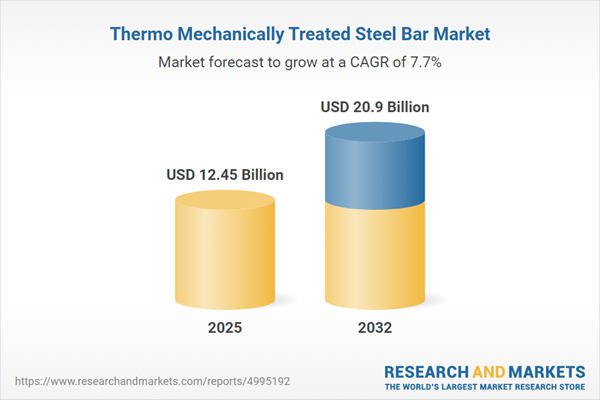Speak directly to the analyst to clarify any post sales queries you may have.
For senior decision-makers, understanding the thermo mechanically treated steel bar market is essential when steering infrastructure, energy, and industrial portfolios toward robust performance and regulatory alignment. This product description delivers actionable clarity on market dynamics, procurement challenges, and emerging strategies tailored to leadership needs.
Market Snapshot: Thermo Mechanically Treated Steel Bar Market
The thermo mechanically treated steel bar market is on a trajectory of substantial expansion, with growth driven by surging demand in construction, automotive, energy, and large-scale infrastructure sectors. The projected market value is set to rise from USD 11.55 billion in 2024 to USD 12.45 billion in 2025, signifying a compound annual growth rate (CAGR) of 7.69%. Advancements in manufacturing standards and adaptable compliance requirements continue to prompt sector-wide innovation, as organizations integrate new product applications and regulatory practices. Manufacturers and suppliers are striving for agility and efficiency, optimizing their operations to meet evolving customer needs and increased expectations for quality and traceability. These dynamics offer leadership opportunities to refresh sourcing strategies, strengthen operational resilience, and better navigate shifting compliance landscapes.
Scope & Segmentation
- Grade Options: Alloy steel bars containing chromium, manganese, or nickel are engineered for durability, particularly in environments with heavy loads or corrosive agents. Carbon steel bars present cost-effective versatility, addressing varied technical requirements across construction, automotive, and related industries.
- Size Range: Bars between 8 and 16 mm are specified for detailed reinforcement in precise engineering applications. The broader 16–40 mm segment is suited for residential and large commercial builds where structural reliability is essential. Sizes above 40 mm support heavy industrial projects demanding maximum strength and stability.
- End User Industries: Automotive manufacturers depend on these steel bars to improve chassis strength and safety, while construction teams use them for compliance with stringent building protocols. Infrastructure, utilities, and energy sectors require long-lasting reinforcement to support asset reliability, and oil and gas operators select these bars for service in difficult environmental conditions and demanding operational cycles.
- Distribution Channels: Project-focused logistics models accommodate delivery to high-demand locations, supporting complex schedules and supply continuity. Established regional networks allow for rapid response and flexible fulfillment, while digital procurement solutions enhance documentation, streamline sourcing, and facilitate better audit management for procurement professionals.
- Regional Overview: Americas’ investment is oriented toward boosting supply chain independence and guarding against external market disturbances. EMEA regions advance process efficiency and sustainability-driven practices in response to evolving regulations. In Asia-Pacific, nations such as China, India, and Japan drive growth through technology integration and the expansion of domestic manufacturing capabilities.
- Key Players: ArcelorMittal S.A., China Baowu Steel Group Corporation Limited, HBIS Group, Nippon Steel Corporation, POSCO, Tata Steel Limited, and Nucor Corporation continually recalibrate their supply strategies, ensuring regulatory compliance while tailoring solutions for sector-specific needs.
Key Takeaways for Senior Leadership
- Update procurement frameworks to address increasingly complex compliance parameters and meet higher standards for sustainability across global operations.
- Harness integrated digital supply chain platforms to drive traceability and strengthen decision-making in rapidly changing market or policy environments.
- Forge collaborative partnerships with suppliers to support ongoing product evolution and optimize logistics, reducing the risk of disruption and ensuring continuity.
- Adopt predictive maintenance analytics to maximize critical asset reliability, reducing downtime and extending operational longevity throughout infrastructure lifecycles.
- Advance circular economy initiatives, such as systematic scrap recycling, for enhanced sustainability and to consistently achieve regulatory alignment.
- Prioritize workforce development, empowering teams with the ability to adapt swiftly to new compliance expectations and maintain competitiveness in dynamic regions.
Tariff Impact and Trade Dynamics
Recent changes to US tariffs on thermo mechanically treated steel bars have introduced new procurement and logistics complexities. Industry participants are responding by refining logistics operations and forming strategic alliances, which create pathways for re-examined sourcing models and enhanced cross-border supply flexibility.
Methodology & Data Sources
These findings are built from direct interviews with senior executives, comprehensive industry analysis, and targeted stakeholder surveys. Standards validation incorporates the latest regulatory data, insights from key market reports, and contributions from major industry associations, ensuring guidance is both reliable and relevant.
Why This Report Matters
- Enables senior leadership to adjust to new global supply conditions and anticipate regulatory trends, maintaining focus on critical operational goals.
- Equips risk and operations teams to adapt procurement and supply strategies with greater resilience in the face of shifting market factors.
- Provides concise intelligence to support strategic planning, fostering smoother project execution and stronger compliance preparedness.
Conclusion
Thermo mechanically treated steel bars play a pivotal role in supporting infrastructure durability and asset performance. This report gives senior executives the insight needed to optimize procurement and ensure agility in a changing landscape.
Additional Product Information:
- Purchase of this report includes 1 year online access with quarterly updates.
- This report can be updated on request. Please contact our Customer Experience team using the Ask a Question widget on our website.
Table of Contents
3. Executive Summary
4. Market Overview
7. Cumulative Impact of Artificial Intelligence 2025
Companies Mentioned
The companies profiled in this Thermo Mechanically Treated Steel Bar market report include:- ArcelorMittal S.A.
- China Baowu Steel Group Corporation Limited
- HBIS Group Co., Ltd.
- Nippon Steel Corporation
- POSCO Co., Ltd.
- Jiangsu Shagang Group Co., Ltd.
- Anshan Iron & Steel Group Corporation
- JFE Steel Corporation
- Tata Steel Limited
- Nucor Corporation
Table Information
| Report Attribute | Details |
|---|---|
| No. of Pages | 199 |
| Published | November 2025 |
| Forecast Period | 2025 - 2032 |
| Estimated Market Value ( USD | $ 12.45 Billion |
| Forecasted Market Value ( USD | $ 20.9 Billion |
| Compound Annual Growth Rate | 7.6% |
| Regions Covered | Global |
| No. of Companies Mentioned | 11 |









